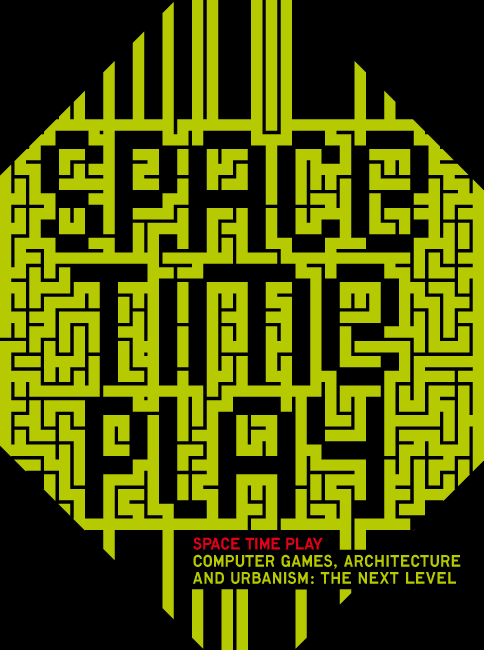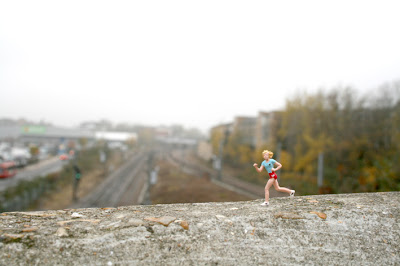
Space Time Play
Computer Games, Architecture and Urbanism: The Next Level
Edited by Friedrich von Borries, Steffen P. Walz and Matthias Böttger
2007 Birkhäuser
496 pages
www.spacetimeplay.org
Book Review
(Disclosure: I contributed two small 300 word reviews to this book. To that end, I guess this review is biased. Still, I think the book is important and has not been reviewed widely enough. So, here’s a good faith effort to share this publication).
Space Time Play is jumbled, incomplete, overreaching and at times, simply confusing. It is also one of the most important books to emerge in recent years in the worlds of videogame theory, urban planning and environmental design.
Subtitled “Computer Games, Architecture and Urbanism: The Next Level†the book stands out as the first systematic effort to connect numerous strands that appear to unite videogames with urban planning, architecture and landscape architecture. Weighing in at close to 500 pages, the book surprisingly barely achieves a rough sketch of what could be said on the topic.
And here lies the central dilemma of Space Time Play. The magnitude of the insight into the game/environment relationship overwhelms the scope of the project. By locating an unexplored nexus in both game studies and the environmental design disciplines, the STP editors have achieved something remarkable. But unable to contain the richness of the insight within the binding, the book groans along, bursting at the seams, context slipping out with the project feeling more like a prototype than a finished work,
But what a prototype it is!
Firing an initial shot in 48 point type, the editors ask: “Why should an architect care about computer games? And what can a game designer take from architecture?†These questions summarize a bold theoretical move, suggesting simultaneously that games have something to do with architecture (here read as the stand in for all environmental design disciplines) and that architecture has something to do with games. Conceptually this does not argue for a methodological borrowing in one direction, such as to suggest that game designers might make more interesting worlds if they would just talk to a planner. Instead, the suggestion is that some hidden linkage exists that ties games to architecture and architecture to games. The connection is organic and inherent, not synthetic or external.
In scope of the material produced, the argument deserves scrutiny.
Ranging from formal analysis of game topologies and theoretical musings on the nature of narrative and the qualities of spatiality to descriptions of games about reality and reality-based videogames, over and over the 60+ essays try to connect to the dots. And while the success of any individual essay depends on the matrices you use to measure it—relevance to architecture, relevance to urban planning, relevance to videogame theory, relevance to game design, etc.—together they present a complex, interwoven description of interactive space, conceptual spatiality, the mediated society, the places of play and play in places.
Most troubling about the book is not the wild collection of essays drawn from fields as diverse as game studies, professional game design, urban planning, cultural studies and architectural theory, but rather the manner in which handled. For example, Espen Aarseth’s indispensable essay “Allegories of Space†notes that it is an abridged version of the original, truncated presumable for reasons of space. However, Daniel Lobo’s “Playing With Urban Life†is similarly edited down from its original, but there is no reference to its source or length. Both essays deserve a place in this collection, but it hurts the book’s utility for the academic researcher if they just “have to know†whether a particular piece of writing lives on in some other form, in different detail.
Similarly, a mixed bag of citation completeness across the essays (some clearly follow an academic discipline of citation unknown to other authors happy to throw out ideas in a casual fashion) and the lack of a comprehensive bibliography overlook simple resources that would significantly improve the usefulness of the collection.
Providing a thematic thread and some visual variety, the book also packages together over a hundred mini-reviews. While focused primarily on games–Katamari Damacy, The Sims, World of Warcraft and others– these short summaries also veer into film, urban games and even a few board games. While there is no strict tie between the subjects of the reviews and the longer essays, the reviews provide a sort of regular beat throughout the book, providing a certain cognitive tempo. In short, while the quality and insight of the review ranges from the thoughtful (Defender) to the obvious (Kingdom Hearts), their regular appearance throughout the book gives the feeling that this goulash of content is simmering toward some clear conclusion.
Which, while it desperately shoots for, does not quite reach.
But you can’t blame the editors for trying Mark Wigley’s book closing essay, “Gamespace†poetically sums what we know and what we don’t know about the play places we call games. Besides, it would be hard to find a more respected architectural theorist to add an additional dash of credibility to this work. Wigley argues for game space unique and attractive nature without closing off discussion with any sort of summary statements about their specific properties.
As a book that has launched a new frontier in scholarship, this open-endeness seems healthy and inspiring.
And, as the editors have their final words, in bold type on the last page of the book, issued as both a call to arms and a declaration ofthe book’s broader intent: Let’s Play!
Technorati Tags: spacetimeplay architecture play


 Anything that Charles Jenks writes is probably worth a look. But when he joyously points to the fun in Bruce Goff’s work, any serious student of play in architecture has to stop and consider what’s going on:
Anything that Charles Jenks writes is probably worth a look. But when he joyously points to the fun in Bruce Goff’s work, any serious student of play in architecture has to stop and consider what’s going on:
